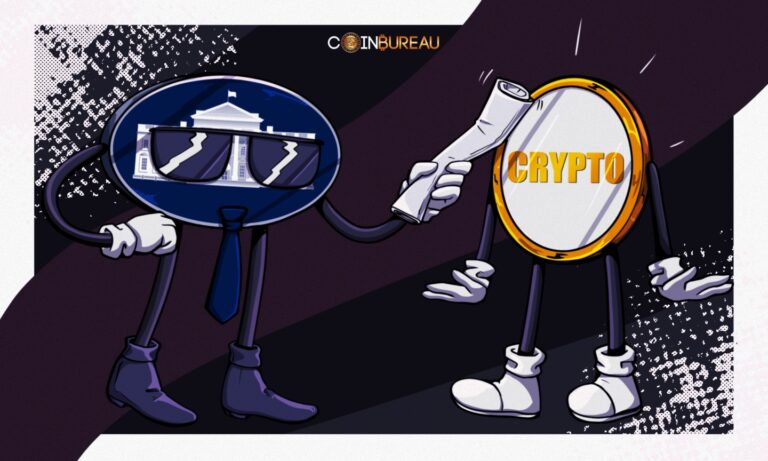Did you know that crypto VC firm Andreessen Horowitz calls itself a16z because there are 16 letters between the A of Andreessen and the Z of Horowitz? Fascinating, I know, but believe me, there’s even more interesting stuff contained within a16z’s recent ‘State of Crypto 2023’ report.
Despite all the bad news, regulatory uncertainty and banking woes battering the crypto market, it has been remarkably resilient of late. Bitcoin recently hit $30k, while ETH soared above $2k in the wake of a successful Shapella upgrade. So, what gives? What might the future hold for the industry, what trends are emerging and which cryptos should we be keeping an eye on?
All this and more is examined in a16z’s report from earlier this month and, to save you the trouble of wading through it yourself, we’ve stepped up to do the honours. In today’s video, we unpack what the folks at a16z are saying, examine what their findings could mean for crypto and give a few of our own thoughts as we go along.
You can watch that video here.
📈 Crypto Market Forecast 📈
This week saw a healthy correction in the crypto market. The recent rally had caused many to wonder whether we were in the midst of a new bull market. This still may be possible, and the recent passing of the MiCA bill by the European Union is one of many pro-crypto regulations we’re going to see over the next few months. This will set the stage for serious institutional investment, but there are some headwinds in the shorter term.
Coinbase will be launching its offshore exchange as soon as this week. The timing couldn’t be better, considering that the SEC gave Coinbase a Wells Notice on the 22nd March. Last Friday marked 30 days since the Wells Notice was issued, which means the actual lawsuit could come soon. That said, the fact that Paxos still hasn’t been sued suggests Coinbase could dodge a bullet – it’s been more than two months since Paxos’ Wells Notice.
The regulatory attacks don’t end there though. DeFi is in the firing line as well, thanks to a report by the US Treasury. In response to that, some protocols have started to float governance proposals related to KYC/AML. Obviously, you can’t force decentralised protocols to comply, but you can target the centralised parts of their infrastructure, like stablecoins. In the case of MakerDAO, it’s transferred almost all of the USDC backing DAI to Coinbase to earn yield. It’s an easy (and existing) target for regulators.
One sector that seems to have been bucking the trend until very recently appears to be NFTs, but even now the sector appears to be getting hit. This could be something to do with all the NFT-based borrowing that’s been going on. The decline in NFT prices could be due to liquidations on those loans, or simply fears that NFT-related DeFi protocols will be targeted by regulators.
In terms of macro factors meanwhile, it appears that US regulators are preparing for a credit event in the non-bank sector. This is because the Financial Stability Oversight Council or FSOC proposed new rules that will give US regulators powers to declare non-bank entities as systemically important. Consider that a “systemically important” designation is how regulators were able to justify bailing out the depositors of Silicon Valley Bank and Signature Bank.
The craziest part is that this new rule would also give US regulators incredible powers over the crypto industry. If you watched our video about bank bail-in laws, you’ll know that FSOC has been wanting to subject non-bank entities to the same laws for months (if not longer). This new rule would give FSOC what it wants, and make it possible to, say, designate Coinbase or Circle as systemically important, shut them down, and sell them to a big bank.
Another macro factor to keep in mind is the ongoing war in Ukraine. Spring is approaching, and the fighting is likely to intensify soon. At the same time, tensions between the United States and China continue to rise. The risk of a potential conflict over Taiwan is likewise increasing. This is evidenced in a tweet by EU President Ursula Von Der Leyen, which seems to imply that China-Taiwan is now more important than Russia-Ukraine.
Say, did you hear that Warren Buffet sold almost all of his TSMC shares? Probably nothing.
👹 MEV Menace 👹
Last week, traders of the PEPE and WOJAK meme coins absolutely hated seeing or hearing anyone say these three words: “Jared from Subway”.
And no, I’m not talking about Subway’s controversial former spokesman, who lost over 100 kgs by just eating Subway sandwiches.
I’m talking about the Ethereum account tied to the ENS address “jaredfromsubway.eth”
Why? Is it because they make really bad sandwiches?
Well… sort of. To be more precise, it’s because jaredfromsubway.eth operates an MEV bot that carries out something called a ‘sandwich’ attack on these traders’ meme coin transactions.
In case you’re unfamiliar, here’s a simplified explanation. An MEV bot is essentially that friend who sneaks a peak at your cards before they bet in a round of poker.
In the context of blockchains, an MEV bot scouts for profitable transactions that are about to be processed on the blockchain and then manipulates the order of these transactions with its own in order to make a profit off the scouted transaction. It typically achieves this by bidding a higher (front-running) or lower (back-running) gas fee than the scouted transaction.
jaredfromsubway.eth’s sandwich attack is a variation of this in which the MEV bot places two transactions – one which it inserts ‘before’ and one which it inserts ‘after’ the scouted transaction (thereby sandwiching it). If the scouted transaction is a DEX buy order for the PEPE meme coin, the MEV bot’s first transaction would push the price of PEPE up by buying it before the scouted transaction, and then its second transaction, which occurs after the scouted transaction, would sell the PEPE it bought (now at a higher price) at a profit.
Notably, jaredfromsubway.eth’s MEV bot was the top gas spender in the Ethereum network on 19th April, accounting for about 7% of the gas spent on that day. It made a profit of roughly $700,000 and spent $1.1 million in gas sandwiching these meme coin transactions, making the bot a net loss of almost $400,000. Yikes.
Situations like this also cause Ethereum’s network to slow down due to increased congestion and transaction fees, leading to a negative impact on the network’s overall efficiency and user experience. Safe to say, Jared’s antics did nobody any good, least of all Jared.
Having said that, it comes as no surprise to find that MEV activity (even with its benefits) has a mostly bad rep. Some estimate that MEV bots have syphoned over $1.38 billion from everyday Ethereum users so far. Moreover, MEV isn’t an issue just native to Ethereum. It affects all blockchains that follow a consensus system that allows certain players to front-run transactions by leveraging information.
So, what’s the solution?
Well, the answer isn’t straightforward. As Tarun Chitra, the founder and CEO of Gauntlet Networks, explains in a recent Blockworks podcast, mitigating MEV is ultimately a matter of choosing between “discriminating at the user level or at the application level”, as any form of MEV mitigation will involve a design choice doing some form of discrimination.
Having said that, the most popular choice currently seems to be one involving the giving of a “kick-back” to users from whose transaction the MEV was extracted. There are two projects that come to mind when I think of this approach: MEVBlocker and Flashbot’s MEV-Share Protocol. Barring implementation differences, both projects focus on distributing a portion of the money made with Maximal Extractable Value (MEV) back to Ethereum users, rather than just validators and block-builders.
However, as time goes on and the building of layer-2 scaling solutions switches the Ethereum ecosystem to a more modular functional system, this approach could change as well. In summary, MEV is a problem that we will have to constantly be innovating against as the ecosystem keeps growing.
📊 Personal Portfolio 📊
BTC 35.52% | ETH 31.80% | USDC 17.39% | USDT 6.96% | USD 3.52% | ATOM 3.41% | DOT 1.41%
🌎 The Coin Bureau Network 🌎
The Coin Bureau has a simple mission: To facilitate the mass adoption of cryptocurrency through education, one person at a time.
And, with that mission in mind, we are constantly looking for ways to expand the reach and diversity of our content.
Did you know about these other channels that are also part of the Coin Bureau network?
🇪🇸 Coin Bureau ES 🇪🇸
This channel is headed up by Marbe (aka, “Crypto Chica”), who along with our Spanish team translates main channel content and presents that to our Spanish and Latin American audience.
Suscríbete ahora a Coin Bureau Español y deja que la Chica Crypto te proporcione la información que tanto te gusta en tu lengua materna.
📹 Latest vid: ¡¡Ataque del Tesoro de los EEUU a la DeFi!! ¡Esto es lo que planean hacer!
📈 Coin Bureau Trading 📈
Coin Bureau Trading is hosted by our resident TA expert, Dan Cheung! He’s a fully verified trader and this channel follows Dan’s journey into the cryptoverse, where he shares his top trading tips, TA and thoughts on the markets.
📹 Latest vid: Scalping, Day Trading or Swing: BEST For Your Gains?!
🇯🇵 Coin Bureau Japan 🇯🇵
This channel offers a Japanese dubbed version of Coin Bureau content. So, if you are one of our friends from Japan you may want to check that out!
📹 Latest vid: 今クリプトはセキュリティに!?何を意味するのか
Speaking of foreign languages, we know that only 17% of the world speaks English while crypto is truly a global revolution.
That is why we are looking to expand our educational content into new markets and countries. So, if this is something you think you could help with, we would love to hear from you (bonus points if it’s in Asia).
Simply fill in the form at the bottom of the page here and we’ll see if we can collaborate with you!
🔮 Video Pipeline 🔮
- Countries Behind The Next Bull Run: What to expect?
- The IMF’s Global CBDC: Is it legit?
- Gary Gensler Hearing Breakdown: What you need to know!
- SEC’s Crypto Crackdown Criteria: What you should know!
🏆 What's New At CoinBureau.com This Week? 🏆
✅ Top Cryptocurrency Exchanges Compared: Head-to-Head Review✅ Polygon 2023: Beginner’s Guide to MATIC
That’s all for this one folks. As always, the whole Coin Bureau Team would like to thank you for your help in our mission. Till next week!
Team Coin BureauDisclosure: Authors may own cryptoassets named in this newsletter. These are unqualified opinions, and a Coin Bureau newsletter, is meant for informational purposes only. It is not meant to serve as investment advice. Please consult with your investment, tax, or legal advisor.














